Business Law Report: Sales of Goods and Consumer Credit
VerifiedAdded on 2020/10/22
|13
|4319
|402
Report
AI Summary
This business law report analyzes various legal principles relevant to business operations. It begins by examining implied terms in the sale of goods, consumer rights, and statutory provisions regarding the transfer of property and possession, including remedies for buyers and sellers in contract disputes. The report then differentiates between types of credit agreements, explores the legal rules for terminating credit rights, and analyzes the general features, rights, and duties of agency. Furthermore, it delves into monopolies, anti-competitive practices, and the role of the competition commission. Finally, the report covers different forms of intellectual property rights, including principles related to the protection of inventions and copyright, comparing and contrasting these protections. The report uses the Consumer Rights Act 2015 and Sales of Goods Act 1979 as a basis for its analysis, providing a comprehensive overview of key legal concepts. The report also discusses faulty goods and remedies for consumers.
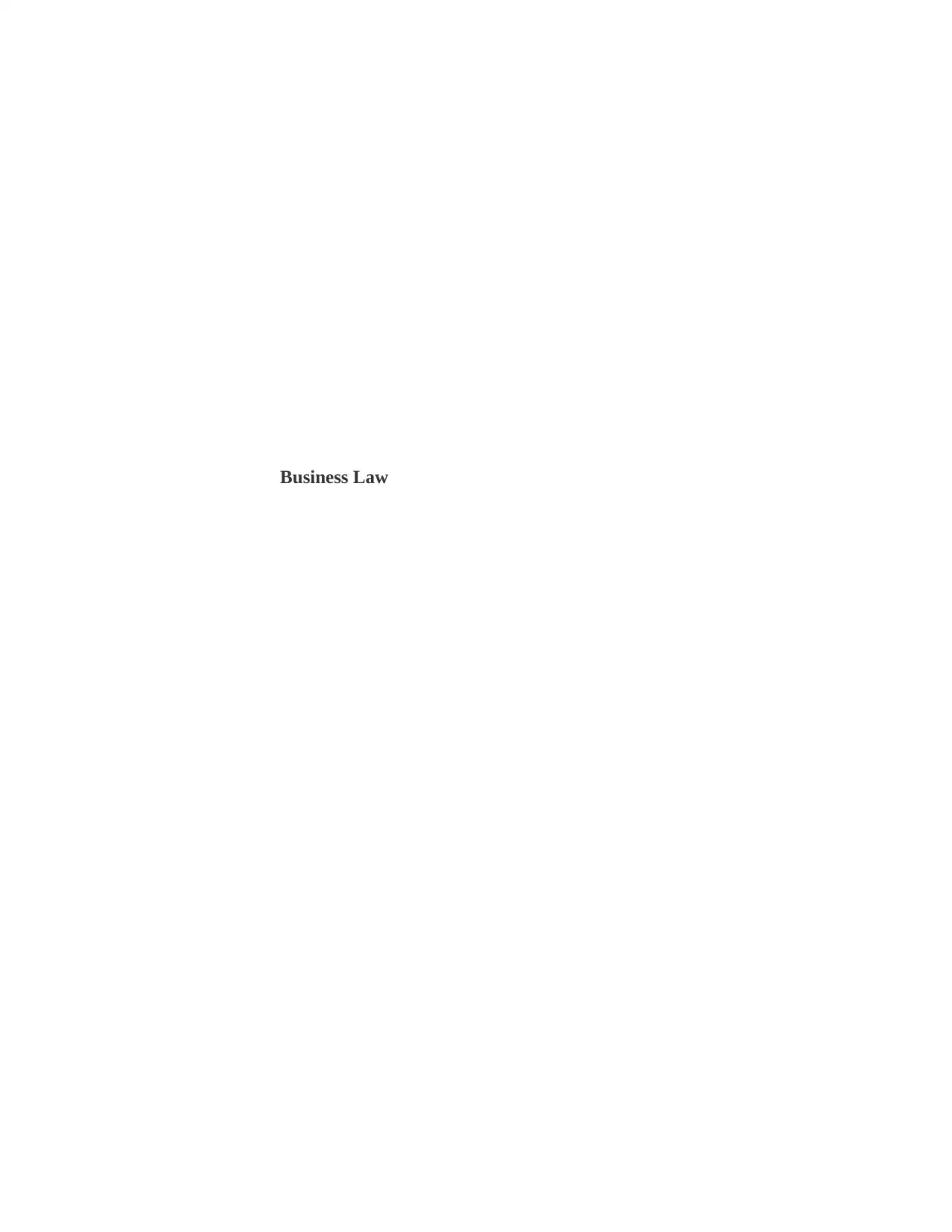
Business Law
Paraphrase This Document
Need a fresh take? Get an instant paraphrase of this document with our AI Paraphraser
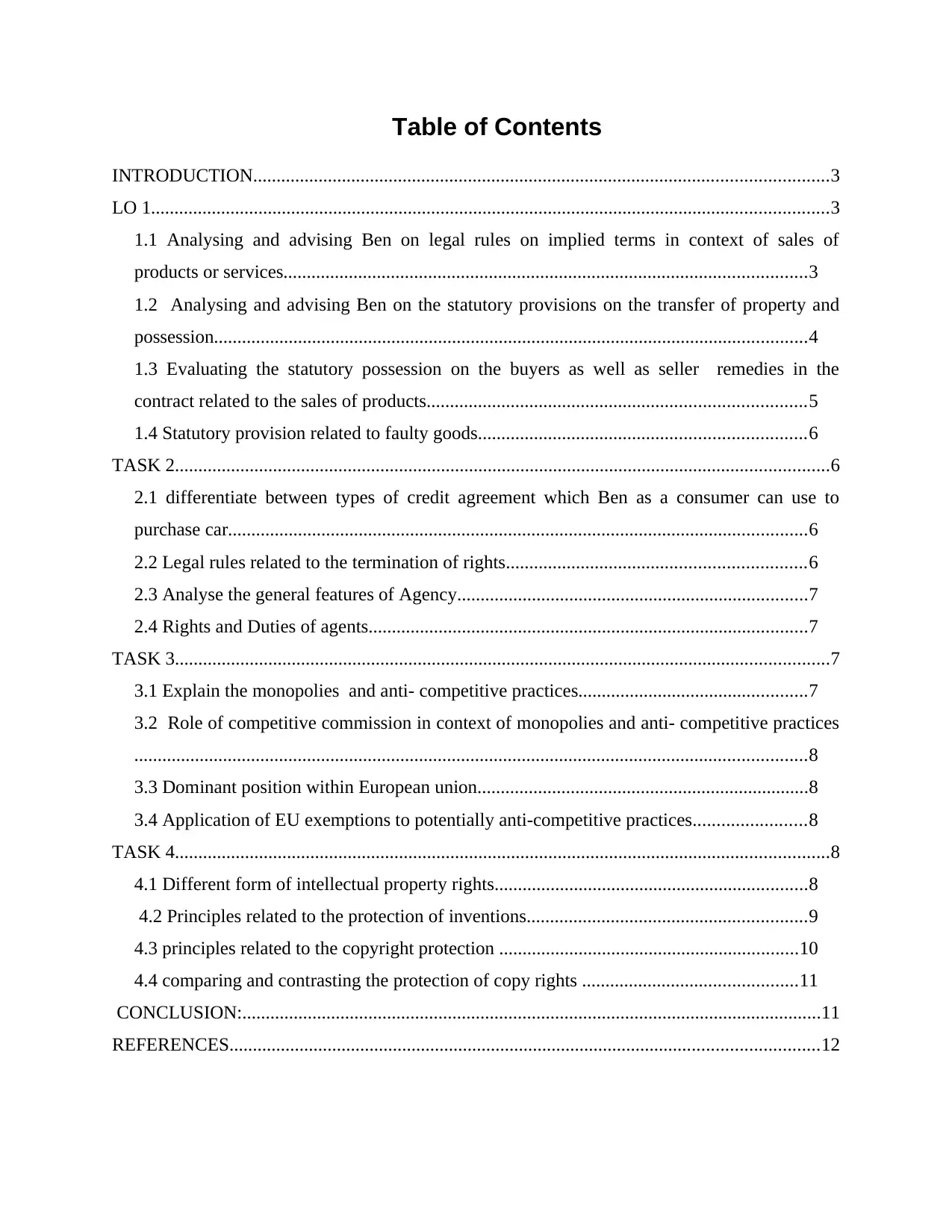
Table of Contents
INTRODUCTION...........................................................................................................................3
LO 1.................................................................................................................................................3
1.1 Analysing and advising Ben on legal rules on implied terms in context of sales of
products or services................................................................................................................3
1.2 Analysing and advising Ben on the statutory provisions on the transfer of property and
possession...............................................................................................................................4
1.3 Evaluating the statutory possession on the buyers as well as seller remedies in the
contract related to the sales of products.................................................................................5
1.4 Statutory provision related to faulty goods......................................................................6
TASK 2............................................................................................................................................6
2.1 differentiate between types of credit agreement which Ben as a consumer can use to
purchase car............................................................................................................................6
2.2 Legal rules related to the termination of rights................................................................6
2.3 Analyse the general features of Agency...........................................................................7
2.4 Rights and Duties of agents..............................................................................................7
TASK 3............................................................................................................................................7
3.1 Explain the monopolies and anti- competitive practices.................................................7
3.2 Role of competitive commission in context of monopolies and anti- competitive practices
................................................................................................................................................8
3.3 Dominant position within European union.......................................................................8
3.4 Application of EU exemptions to potentially anti-competitive practices........................8
TASK 4............................................................................................................................................8
4.1 Different form of intellectual property rights...................................................................8
4.2 Principles related to the protection of inventions............................................................9
4.3 principles related to the copyright protection ................................................................10
4.4 comparing and contrasting the protection of copy rights ..............................................11
CONCLUSION:............................................................................................................................11
REFERENCES..............................................................................................................................12
INTRODUCTION...........................................................................................................................3
LO 1.................................................................................................................................................3
1.1 Analysing and advising Ben on legal rules on implied terms in context of sales of
products or services................................................................................................................3
1.2 Analysing and advising Ben on the statutory provisions on the transfer of property and
possession...............................................................................................................................4
1.3 Evaluating the statutory possession on the buyers as well as seller remedies in the
contract related to the sales of products.................................................................................5
1.4 Statutory provision related to faulty goods......................................................................6
TASK 2............................................................................................................................................6
2.1 differentiate between types of credit agreement which Ben as a consumer can use to
purchase car............................................................................................................................6
2.2 Legal rules related to the termination of rights................................................................6
2.3 Analyse the general features of Agency...........................................................................7
2.4 Rights and Duties of agents..............................................................................................7
TASK 3............................................................................................................................................7
3.1 Explain the monopolies and anti- competitive practices.................................................7
3.2 Role of competitive commission in context of monopolies and anti- competitive practices
................................................................................................................................................8
3.3 Dominant position within European union.......................................................................8
3.4 Application of EU exemptions to potentially anti-competitive practices........................8
TASK 4............................................................................................................................................8
4.1 Different form of intellectual property rights...................................................................8
4.2 Principles related to the protection of inventions............................................................9
4.3 principles related to the copyright protection ................................................................10
4.4 comparing and contrasting the protection of copy rights ..............................................11
CONCLUSION:............................................................................................................................11
REFERENCES..............................................................................................................................12

INTRODUCTION
Legislation which regulates business activities are defined as business law. Such types of
laws are also recognised as the commercial legislation. These norms are designed by the
government in order to protect organisations from unfair competition within an industry.
Objectives of forming commercial law is to support business entities in resolving several issues
as well as commercial disputes in systematic manner. Business law covers all the aspects ranging
from establishing a company to running an organisation in systematic manner. This legislation
governs as well as regulates the several commercial activities including the sales of goods act ,
contracts between two parties , manufacturing of products or services , hiring practices etc.
Legislation related to business is required by an entrepreneur to considered and follow when
establishing new company , merger , acquisition etc.
The present report has focus on developing the understanding about the regulation
created by the government in relation to the supply of products or services. It also has focus on
identifying the rights as well as duties of an agent. Assignment also have emphasizes on
explaining the several forms of intellectual property rights.
LO 1
1.1 Analysing and advising Ben on legal rules on implied terms in context of sales of products
or services
In the given case scenario, Consumer right, 2015 is applicable. This provision is
applicable where the sales of product include description when there is an implied term that
the goods must match the description. Consumer Rights Act 2015 , as per this act Ben has the
right to file law suit against the company, if he found that the quality of goods includes their
state and condition, included in description are not of same quality. This act covers the several
aspects of the legislation which is covered by sales of product Act 1979. There are some basic
principles are applied to the sales as well as supply of products or services . The different
provision in the consumer right act are implied by statue with the providing protection to
customers. The another major sources of evolution of several provisions in sale and supply of
products is Consumer right act,2015. According to the provision of sales of goods acts and
supply of product or service act, the retailer or seller of products does not have right to sell the
defected goods or services. When the products are sol by the seller by description there is a clear
term . As per the supply of goods act It is required by the seller or manufacture to ensure the
Legislation which regulates business activities are defined as business law. Such types of
laws are also recognised as the commercial legislation. These norms are designed by the
government in order to protect organisations from unfair competition within an industry.
Objectives of forming commercial law is to support business entities in resolving several issues
as well as commercial disputes in systematic manner. Business law covers all the aspects ranging
from establishing a company to running an organisation in systematic manner. This legislation
governs as well as regulates the several commercial activities including the sales of goods act ,
contracts between two parties , manufacturing of products or services , hiring practices etc.
Legislation related to business is required by an entrepreneur to considered and follow when
establishing new company , merger , acquisition etc.
The present report has focus on developing the understanding about the regulation
created by the government in relation to the supply of products or services. It also has focus on
identifying the rights as well as duties of an agent. Assignment also have emphasizes on
explaining the several forms of intellectual property rights.
LO 1
1.1 Analysing and advising Ben on legal rules on implied terms in context of sales of products
or services
In the given case scenario, Consumer right, 2015 is applicable. This provision is
applicable where the sales of product include description when there is an implied term that
the goods must match the description. Consumer Rights Act 2015 , as per this act Ben has the
right to file law suit against the company, if he found that the quality of goods includes their
state and condition, included in description are not of same quality. This act covers the several
aspects of the legislation which is covered by sales of product Act 1979. There are some basic
principles are applied to the sales as well as supply of products or services . The different
provision in the consumer right act are implied by statue with the providing protection to
customers. The another major sources of evolution of several provisions in sale and supply of
products is Consumer right act,2015. According to the provision of sales of goods acts and
supply of product or service act, the retailer or seller of products does not have right to sell the
defected goods or services. When the products are sol by the seller by description there is a clear
term . As per the supply of goods act It is required by the seller or manufacture to ensure the
⊘ This is a preview!⊘
Do you want full access?
Subscribe today to unlock all pages.

Trusted by 1+ million students worldwide
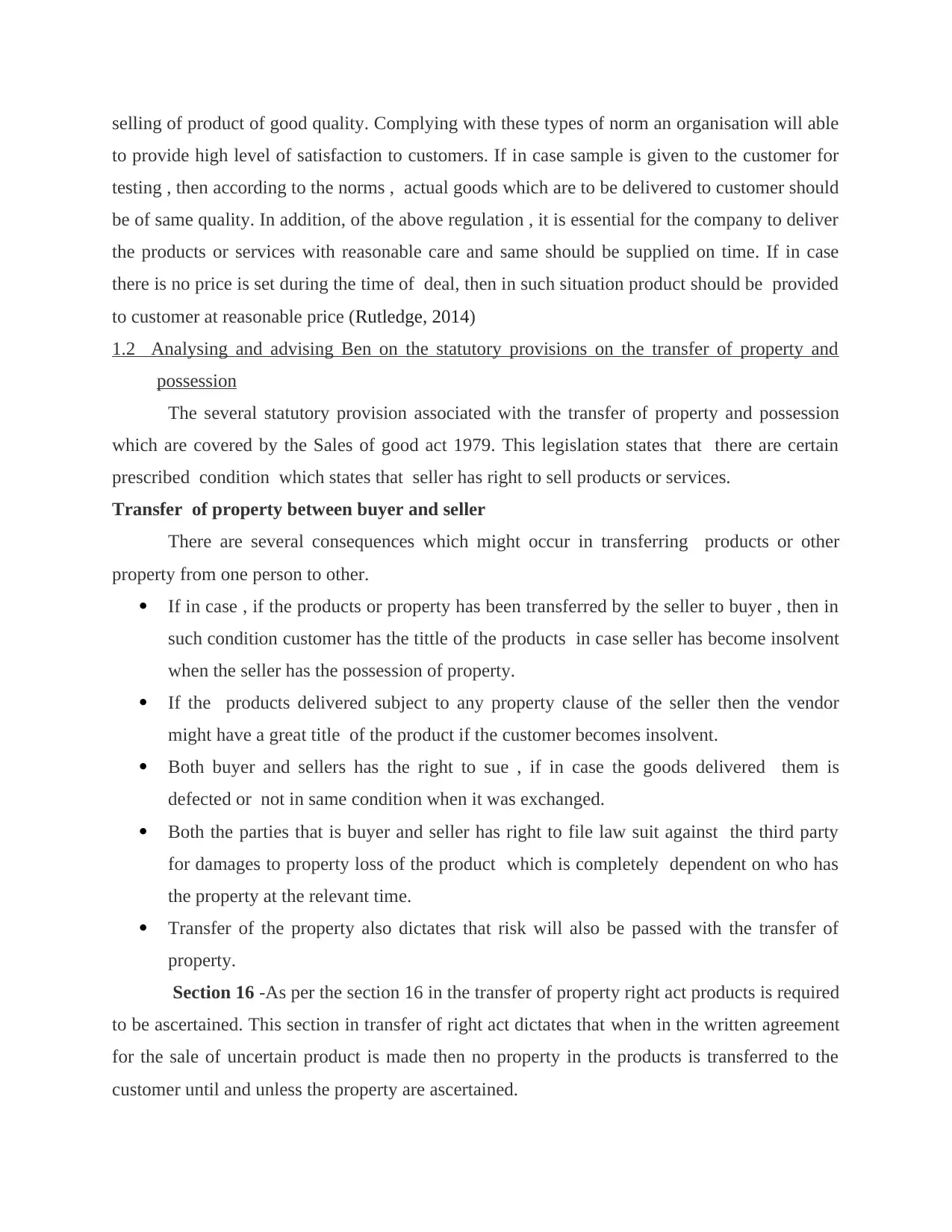
selling of product of good quality. Complying with these types of norm an organisation will able
to provide high level of satisfaction to customers. If in case sample is given to the customer for
testing , then according to the norms , actual goods which are to be delivered to customer should
be of same quality. In addition, of the above regulation , it is essential for the company to deliver
the products or services with reasonable care and same should be supplied on time. If in case
there is no price is set during the time of deal, then in such situation product should be provided
to customer at reasonable price (Rutledge, 2014)
1.2 Analysing and advising Ben on the statutory provisions on the transfer of property and
possession
The several statutory provision associated with the transfer of property and possession
which are covered by the Sales of good act 1979. This legislation states that there are certain
prescribed condition which states that seller has right to sell products or services.
Transfer of property between buyer and seller
There are several consequences which might occur in transferring products or other
property from one person to other.
If in case , if the products or property has been transferred by the seller to buyer , then in
such condition customer has the tittle of the products in case seller has become insolvent
when the seller has the possession of property.
If the products delivered subject to any property clause of the seller then the vendor
might have a great title of the product if the customer becomes insolvent.
Both buyer and sellers has the right to sue , if in case the goods delivered them is
defected or not in same condition when it was exchanged.
Both the parties that is buyer and seller has right to file law suit against the third party
for damages to property loss of the product which is completely dependent on who has
the property at the relevant time.
Transfer of the property also dictates that risk will also be passed with the transfer of
property.
Section 16 -As per the section 16 in the transfer of property right act products is required
to be ascertained. This section in transfer of right act dictates that when in the written agreement
for the sale of uncertain product is made then no property in the products is transferred to the
customer until and unless the property are ascertained.
to provide high level of satisfaction to customers. If in case sample is given to the customer for
testing , then according to the norms , actual goods which are to be delivered to customer should
be of same quality. In addition, of the above regulation , it is essential for the company to deliver
the products or services with reasonable care and same should be supplied on time. If in case
there is no price is set during the time of deal, then in such situation product should be provided
to customer at reasonable price (Rutledge, 2014)
1.2 Analysing and advising Ben on the statutory provisions on the transfer of property and
possession
The several statutory provision associated with the transfer of property and possession
which are covered by the Sales of good act 1979. This legislation states that there are certain
prescribed condition which states that seller has right to sell products or services.
Transfer of property between buyer and seller
There are several consequences which might occur in transferring products or other
property from one person to other.
If in case , if the products or property has been transferred by the seller to buyer , then in
such condition customer has the tittle of the products in case seller has become insolvent
when the seller has the possession of property.
If the products delivered subject to any property clause of the seller then the vendor
might have a great title of the product if the customer becomes insolvent.
Both buyer and sellers has the right to sue , if in case the goods delivered them is
defected or not in same condition when it was exchanged.
Both the parties that is buyer and seller has right to file law suit against the third party
for damages to property loss of the product which is completely dependent on who has
the property at the relevant time.
Transfer of the property also dictates that risk will also be passed with the transfer of
property.
Section 16 -As per the section 16 in the transfer of property right act products is required
to be ascertained. This section in transfer of right act dictates that when in the written agreement
for the sale of uncertain product is made then no property in the products is transferred to the
customer until and unless the property are ascertained.
Paraphrase This Document
Need a fresh take? Get an instant paraphrase of this document with our AI Paraphraser
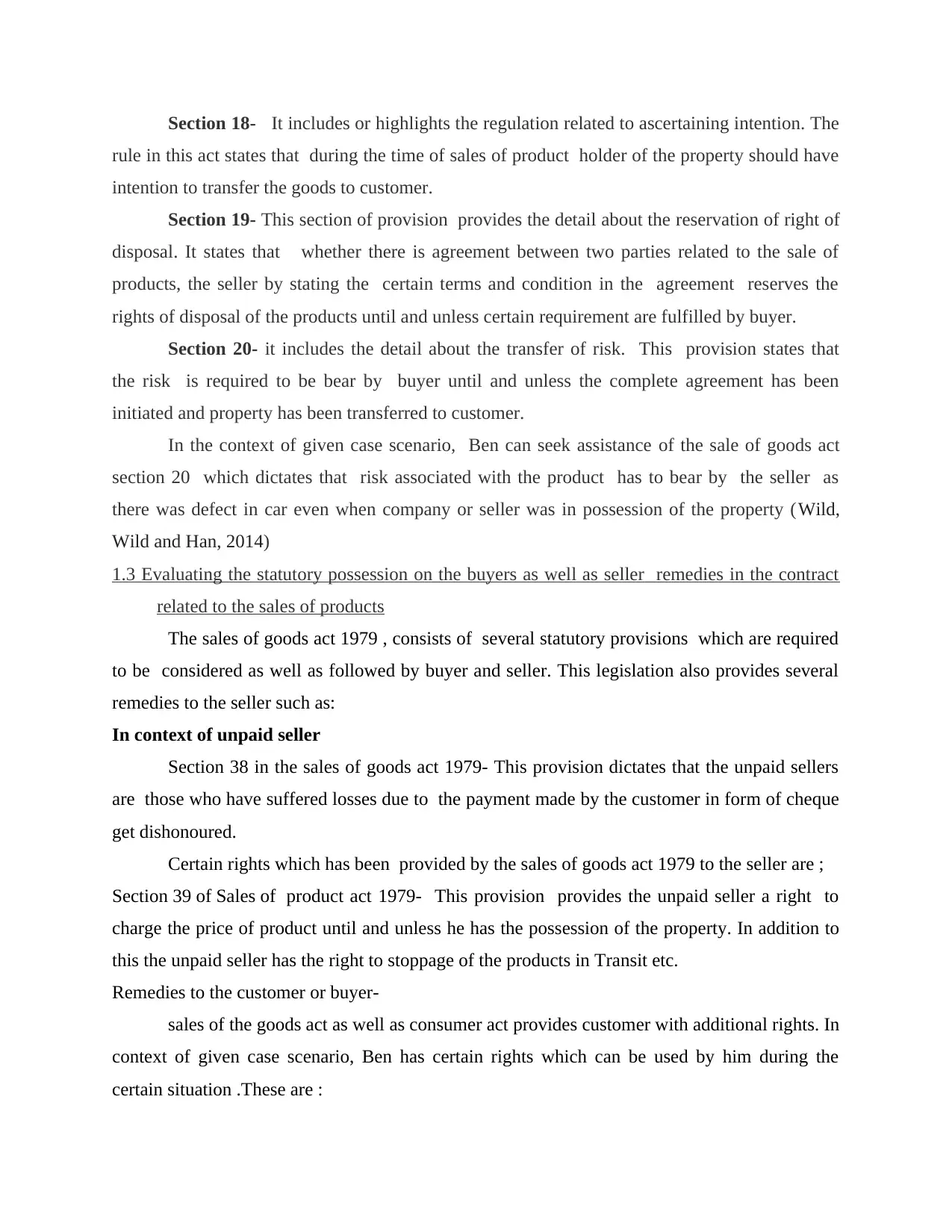
Section 18- It includes or highlights the regulation related to ascertaining intention. The
rule in this act states that during the time of sales of product holder of the property should have
intention to transfer the goods to customer.
Section 19- This section of provision provides the detail about the reservation of right of
disposal. It states that whether there is agreement between two parties related to the sale of
products, the seller by stating the certain terms and condition in the agreement reserves the
rights of disposal of the products until and unless certain requirement are fulfilled by buyer.
Section 20- it includes the detail about the transfer of risk. This provision states that
the risk is required to be bear by buyer until and unless the complete agreement has been
initiated and property has been transferred to customer.
In the context of given case scenario, Ben can seek assistance of the sale of goods act
section 20 which dictates that risk associated with the product has to bear by the seller as
there was defect in car even when company or seller was in possession of the property (Wild,
Wild and Han, 2014)
1.3 Evaluating the statutory possession on the buyers as well as seller remedies in the contract
related to the sales of products
The sales of goods act 1979 , consists of several statutory provisions which are required
to be considered as well as followed by buyer and seller. This legislation also provides several
remedies to the seller such as:
In context of unpaid seller
Section 38 in the sales of goods act 1979- This provision dictates that the unpaid sellers
are those who have suffered losses due to the payment made by the customer in form of cheque
get dishonoured.
Certain rights which has been provided by the sales of goods act 1979 to the seller are ;
Section 39 of Sales of product act 1979- This provision provides the unpaid seller a right to
charge the price of product until and unless he has the possession of the property. In addition to
this the unpaid seller has the right to stoppage of the products in Transit etc.
Remedies to the customer or buyer-
sales of the goods act as well as consumer act provides customer with additional rights. In
context of given case scenario, Ben has certain rights which can be used by him during the
certain situation .These are :
rule in this act states that during the time of sales of product holder of the property should have
intention to transfer the goods to customer.
Section 19- This section of provision provides the detail about the reservation of right of
disposal. It states that whether there is agreement between two parties related to the sale of
products, the seller by stating the certain terms and condition in the agreement reserves the
rights of disposal of the products until and unless certain requirement are fulfilled by buyer.
Section 20- it includes the detail about the transfer of risk. This provision states that
the risk is required to be bear by buyer until and unless the complete agreement has been
initiated and property has been transferred to customer.
In the context of given case scenario, Ben can seek assistance of the sale of goods act
section 20 which dictates that risk associated with the product has to bear by the seller as
there was defect in car even when company or seller was in possession of the property (Wild,
Wild and Han, 2014)
1.3 Evaluating the statutory possession on the buyers as well as seller remedies in the contract
related to the sales of products
The sales of goods act 1979 , consists of several statutory provisions which are required
to be considered as well as followed by buyer and seller. This legislation also provides several
remedies to the seller such as:
In context of unpaid seller
Section 38 in the sales of goods act 1979- This provision dictates that the unpaid sellers
are those who have suffered losses due to the payment made by the customer in form of cheque
get dishonoured.
Certain rights which has been provided by the sales of goods act 1979 to the seller are ;
Section 39 of Sales of product act 1979- This provision provides the unpaid seller a right to
charge the price of product until and unless he has the possession of the property. In addition to
this the unpaid seller has the right to stoppage of the products in Transit etc.
Remedies to the customer or buyer-
sales of the goods act as well as consumer act provides customer with additional rights. In
context of given case scenario, Ben has certain rights which can be used by him during the
certain situation .These are :
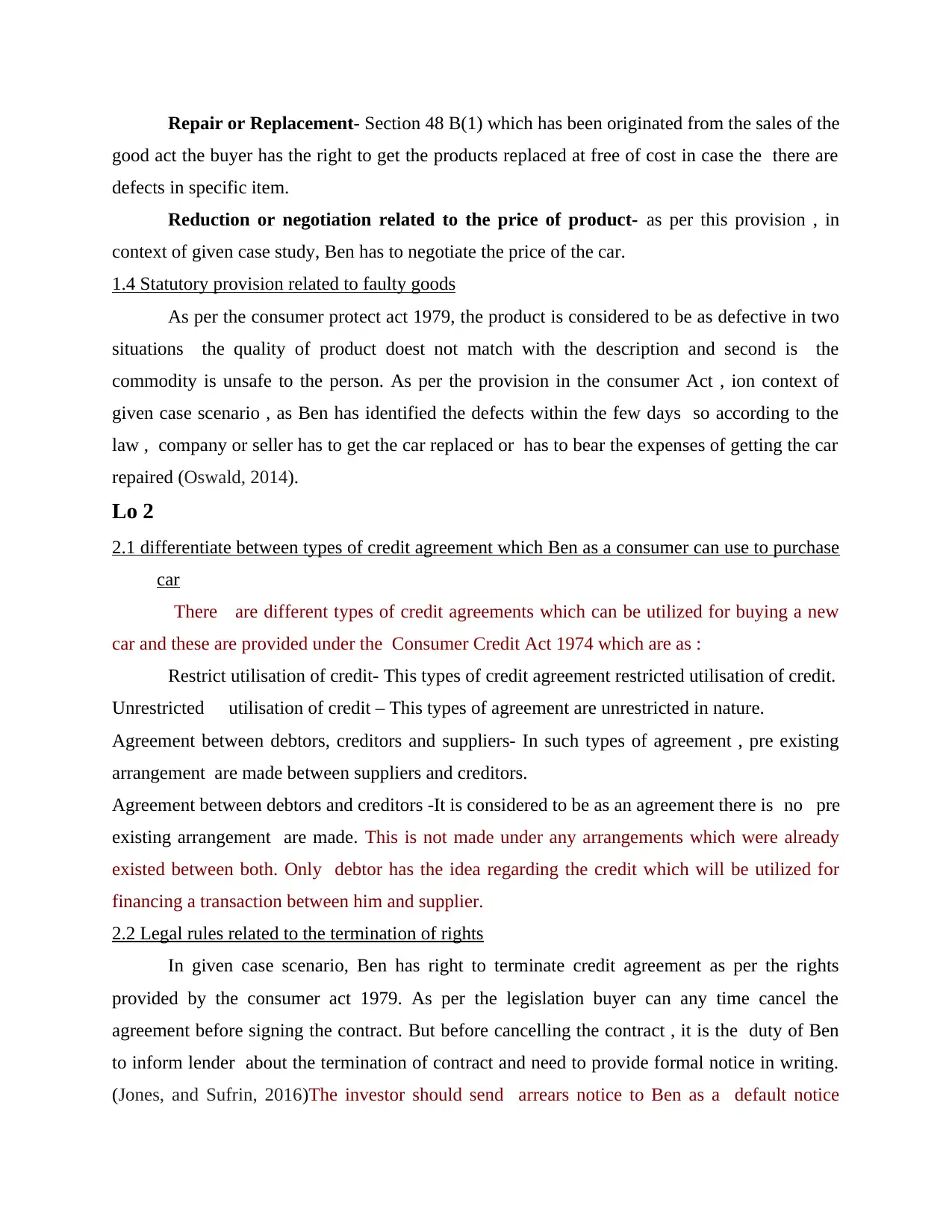
Repair or Replacement- Section 48 B(1) which has been originated from the sales of the
good act the buyer has the right to get the products replaced at free of cost in case the there are
defects in specific item.
Reduction or negotiation related to the price of product- as per this provision , in
context of given case study, Ben has to negotiate the price of the car.
1.4 Statutory provision related to faulty goods
As per the consumer protect act 1979, the product is considered to be as defective in two
situations the quality of product doest not match with the description and second is the
commodity is unsafe to the person. As per the provision in the consumer Act , ion context of
given case scenario , as Ben has identified the defects within the few days so according to the
law , company or seller has to get the car replaced or has to bear the expenses of getting the car
repaired (Oswald, 2014).
Lo 2
2.1 differentiate between types of credit agreement which Ben as a consumer can use to purchase
car
There are different types of credit agreements which can be utilized for buying a new
car and these are provided under the Consumer Credit Act 1974 which are as :
Restrict utilisation of credit- This types of credit agreement restricted utilisation of credit.
Unrestricted utilisation of credit – This types of agreement are unrestricted in nature.
Agreement between debtors, creditors and suppliers- In such types of agreement , pre existing
arrangement are made between suppliers and creditors.
Agreement between debtors and creditors -It is considered to be as an agreement there is no pre
existing arrangement are made. This is not made under any arrangements which were already
existed between both. Only debtor has the idea regarding the credit which will be utilized for
financing a transaction between him and supplier.
2.2 Legal rules related to the termination of rights
In given case scenario, Ben has right to terminate credit agreement as per the rights
provided by the consumer act 1979. As per the legislation buyer can any time cancel the
agreement before signing the contract. But before cancelling the contract , it is the duty of Ben
to inform lender about the termination of contract and need to provide formal notice in writing.
(Jones, and Sufrin, 2016)The investor should send arrears notice to Ben as a default notice
good act the buyer has the right to get the products replaced at free of cost in case the there are
defects in specific item.
Reduction or negotiation related to the price of product- as per this provision , in
context of given case study, Ben has to negotiate the price of the car.
1.4 Statutory provision related to faulty goods
As per the consumer protect act 1979, the product is considered to be as defective in two
situations the quality of product doest not match with the description and second is the
commodity is unsafe to the person. As per the provision in the consumer Act , ion context of
given case scenario , as Ben has identified the defects within the few days so according to the
law , company or seller has to get the car replaced or has to bear the expenses of getting the car
repaired (Oswald, 2014).
Lo 2
2.1 differentiate between types of credit agreement which Ben as a consumer can use to purchase
car
There are different types of credit agreements which can be utilized for buying a new
car and these are provided under the Consumer Credit Act 1974 which are as :
Restrict utilisation of credit- This types of credit agreement restricted utilisation of credit.
Unrestricted utilisation of credit – This types of agreement are unrestricted in nature.
Agreement between debtors, creditors and suppliers- In such types of agreement , pre existing
arrangement are made between suppliers and creditors.
Agreement between debtors and creditors -It is considered to be as an agreement there is no pre
existing arrangement are made. This is not made under any arrangements which were already
existed between both. Only debtor has the idea regarding the credit which will be utilized for
financing a transaction between him and supplier.
2.2 Legal rules related to the termination of rights
In given case scenario, Ben has right to terminate credit agreement as per the rights
provided by the consumer act 1979. As per the legislation buyer can any time cancel the
agreement before signing the contract. But before cancelling the contract , it is the duty of Ben
to inform lender about the termination of contract and need to provide formal notice in writing.
(Jones, and Sufrin, 2016)The investor should send arrears notice to Ben as a default notice
⊘ This is a preview!⊘
Do you want full access?
Subscribe today to unlock all pages.

Trusted by 1+ million students worldwide
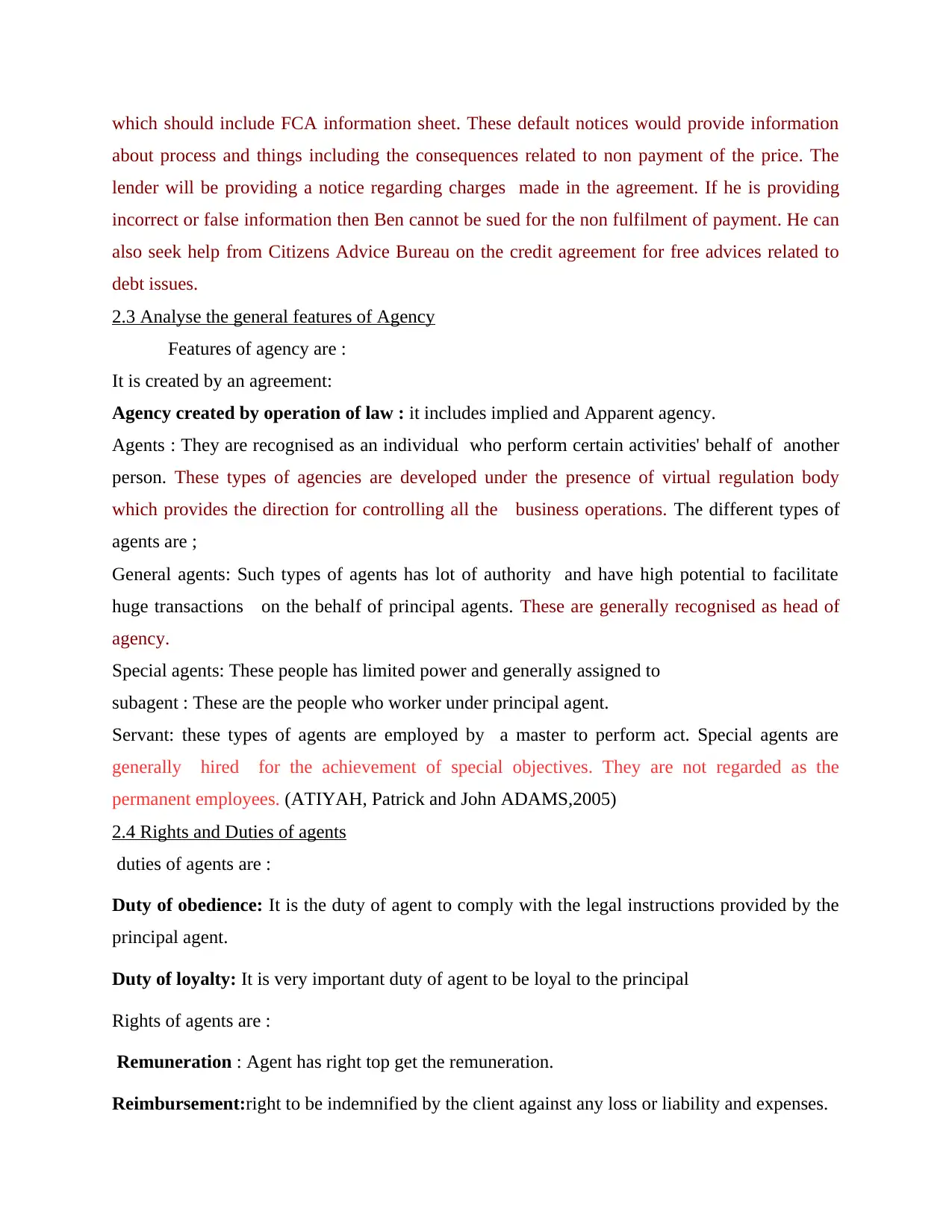
which should include FCA information sheet. These default notices would provide information
about process and things including the consequences related to non payment of the price. The
lender will be providing a notice regarding charges made in the agreement. If he is providing
incorrect or false information then Ben cannot be sued for the non fulfilment of payment. He can
also seek help from Citizens Advice Bureau on the credit agreement for free advices related to
debt issues.
2.3 Analyse the general features of Agency
Features of agency are :
It is created by an agreement:
Agency created by operation of law : it includes implied and Apparent agency.
Agents : They are recognised as an individual who perform certain activities' behalf of another
person. These types of agencies are developed under the presence of virtual regulation body
which provides the direction for controlling all the business operations. The different types of
agents are ;
General agents: Such types of agents has lot of authority and have high potential to facilitate
huge transactions on the behalf of principal agents. These are generally recognised as head of
agency.
Special agents: These people has limited power and generally assigned to
subagent : These are the people who worker under principal agent.
Servant: these types of agents are employed by a master to perform act. Special agents are
generally hired for the achievement of special objectives. They are not regarded as the
permanent employees. (ATIYAH, Patrick and John ADAMS,2005)
2.4 Rights and Duties of agents
duties of agents are :
Duty of obedience: It is the duty of agent to comply with the legal instructions provided by the
principal agent.
Duty of loyalty: It is very important duty of agent to be loyal to the principal
Rights of agents are :
Remuneration : Agent has right top get the remuneration.
Reimbursement:right to be indemnified by the client against any loss or liability and expenses.
about process and things including the consequences related to non payment of the price. The
lender will be providing a notice regarding charges made in the agreement. If he is providing
incorrect or false information then Ben cannot be sued for the non fulfilment of payment. He can
also seek help from Citizens Advice Bureau on the credit agreement for free advices related to
debt issues.
2.3 Analyse the general features of Agency
Features of agency are :
It is created by an agreement:
Agency created by operation of law : it includes implied and Apparent agency.
Agents : They are recognised as an individual who perform certain activities' behalf of another
person. These types of agencies are developed under the presence of virtual regulation body
which provides the direction for controlling all the business operations. The different types of
agents are ;
General agents: Such types of agents has lot of authority and have high potential to facilitate
huge transactions on the behalf of principal agents. These are generally recognised as head of
agency.
Special agents: These people has limited power and generally assigned to
subagent : These are the people who worker under principal agent.
Servant: these types of agents are employed by a master to perform act. Special agents are
generally hired for the achievement of special objectives. They are not regarded as the
permanent employees. (ATIYAH, Patrick and John ADAMS,2005)
2.4 Rights and Duties of agents
duties of agents are :
Duty of obedience: It is the duty of agent to comply with the legal instructions provided by the
principal agent.
Duty of loyalty: It is very important duty of agent to be loyal to the principal
Rights of agents are :
Remuneration : Agent has right top get the remuneration.
Reimbursement:right to be indemnified by the client against any loss or liability and expenses.
Paraphrase This Document
Need a fresh take? Get an instant paraphrase of this document with our AI Paraphraser
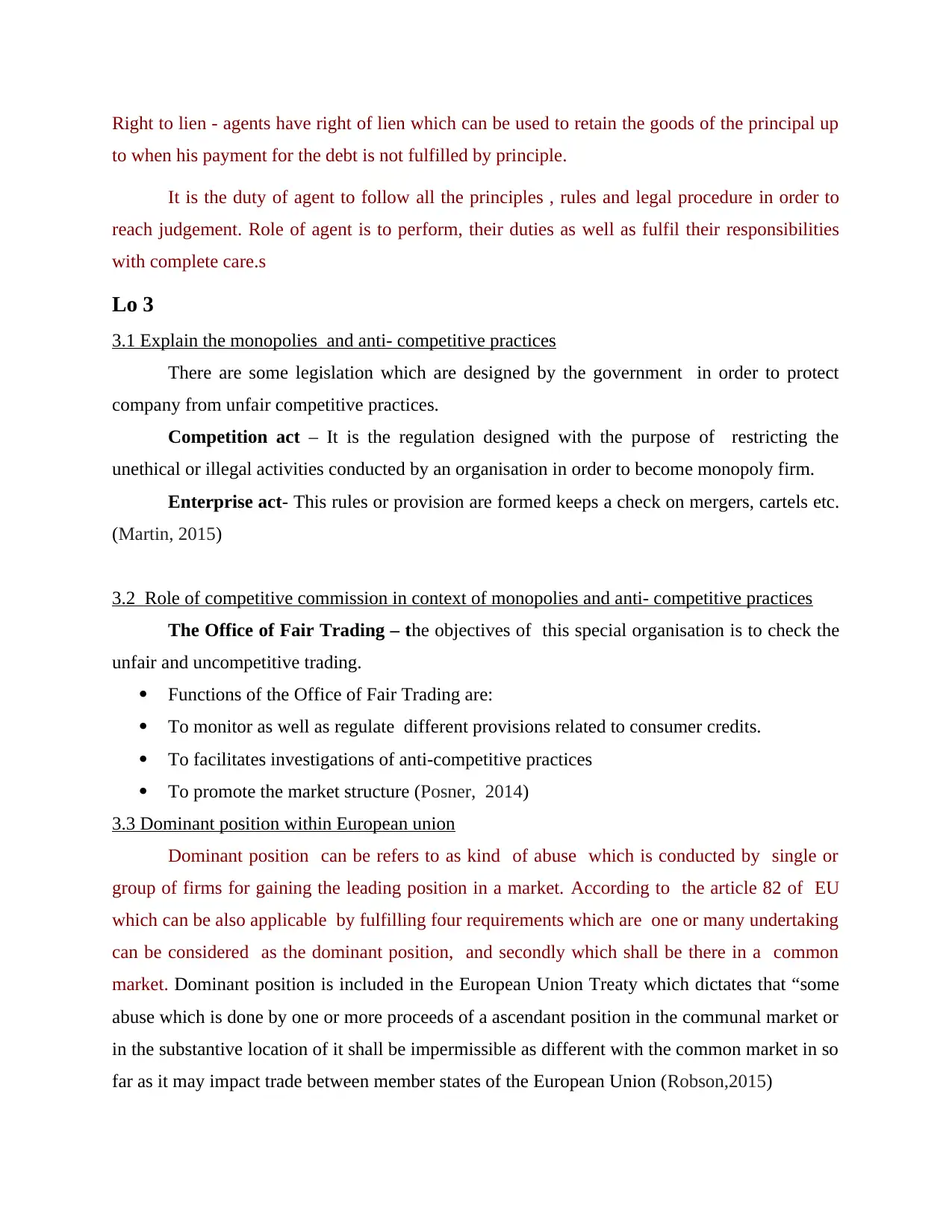
Right to lien - agents have right of lien which can be used to retain the goods of the principal up
to when his payment for the debt is not fulfilled by principle.
It is the duty of agent to follow all the principles , rules and legal procedure in order to
reach judgement. Role of agent is to perform, their duties as well as fulfil their responsibilities
with complete care.s
Lo 3
3.1 Explain the monopolies and anti- competitive practices
There are some legislation which are designed by the government in order to protect
company from unfair competitive practices.
Competition act – It is the regulation designed with the purpose of restricting the
unethical or illegal activities conducted by an organisation in order to become monopoly firm.
Enterprise act- This rules or provision are formed keeps a check on mergers, cartels etc.
(Martin, 2015)
3.2 Role of competitive commission in context of monopolies and anti- competitive practices
The Office of Fair Trading – the objectives of this special organisation is to check the
unfair and uncompetitive trading.
Functions of the Office of Fair Trading are:
To monitor as well as regulate different provisions related to consumer credits.
To facilitates investigations of anti-competitive practices
To promote the market structure (Posner, 2014)
3.3 Dominant position within European union
Dominant position can be refers to as kind of abuse which is conducted by single or
group of firms for gaining the leading position in a market. According to the article 82 of EU
which can be also applicable by fulfilling four requirements which are one or many undertaking
can be considered as the dominant position, and secondly which shall be there in a common
market. Dominant position is included in the European Union Treaty which dictates that “some
abuse which is done by one or more proceeds of a ascendant position in the communal market or
in the substantive location of it shall be impermissible as different with the common market in so
far as it may impact trade between member states of the European Union (Robson,2015)
to when his payment for the debt is not fulfilled by principle.
It is the duty of agent to follow all the principles , rules and legal procedure in order to
reach judgement. Role of agent is to perform, their duties as well as fulfil their responsibilities
with complete care.s
Lo 3
3.1 Explain the monopolies and anti- competitive practices
There are some legislation which are designed by the government in order to protect
company from unfair competitive practices.
Competition act – It is the regulation designed with the purpose of restricting the
unethical or illegal activities conducted by an organisation in order to become monopoly firm.
Enterprise act- This rules or provision are formed keeps a check on mergers, cartels etc.
(Martin, 2015)
3.2 Role of competitive commission in context of monopolies and anti- competitive practices
The Office of Fair Trading – the objectives of this special organisation is to check the
unfair and uncompetitive trading.
Functions of the Office of Fair Trading are:
To monitor as well as regulate different provisions related to consumer credits.
To facilitates investigations of anti-competitive practices
To promote the market structure (Posner, 2014)
3.3 Dominant position within European union
Dominant position can be refers to as kind of abuse which is conducted by single or
group of firms for gaining the leading position in a market. According to the article 82 of EU
which can be also applicable by fulfilling four requirements which are one or many undertaking
can be considered as the dominant position, and secondly which shall be there in a common
market. Dominant position is included in the European Union Treaty which dictates that “some
abuse which is done by one or more proceeds of a ascendant position in the communal market or
in the substantive location of it shall be impermissible as different with the common market in so
far as it may impact trade between member states of the European Union (Robson,2015)
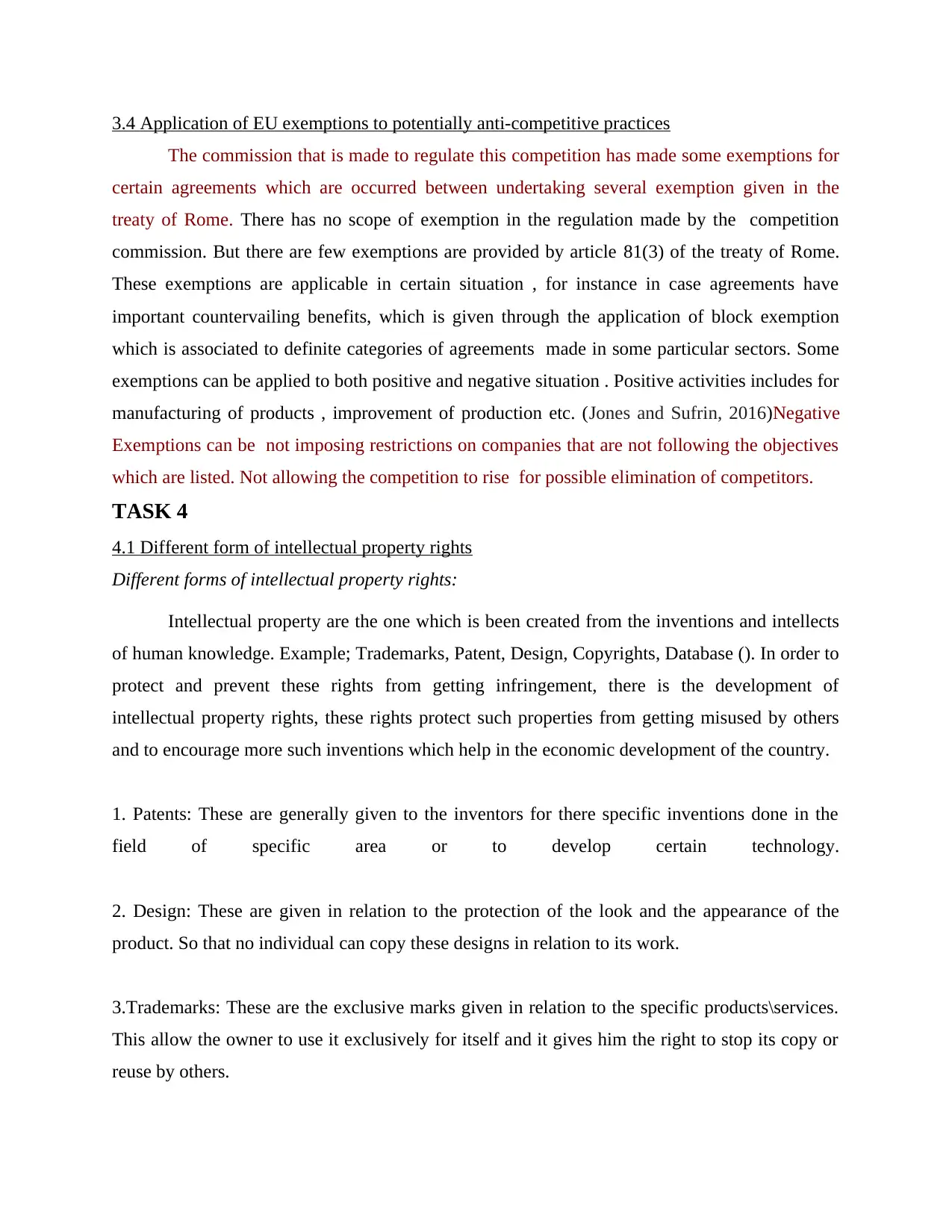
3.4 Application of EU exemptions to potentially anti-competitive practices
The commission that is made to regulate this competition has made some exemptions for
certain agreements which are occurred between undertaking several exemption given in the
treaty of Rome. There has no scope of exemption in the regulation made by the competition
commission. But there are few exemptions are provided by article 81(3) of the treaty of Rome.
These exemptions are applicable in certain situation , for instance in case agreements have
important countervailing benefits, which is given through the application of block exemption
which is associated to definite categories of agreements made in some particular sectors. Some
exemptions can be applied to both positive and negative situation . Positive activities includes for
manufacturing of products , improvement of production etc. (Jones and Sufrin, 2016)Negative
Exemptions can be not imposing restrictions on companies that are not following the objectives
which are listed. Not allowing the competition to rise for possible elimination of competitors.
TASK 4
4.1 Different form of intellectual property rights
Different forms of intellectual property rights:
Intellectual property are the one which is been created from the inventions and intellects
of human knowledge. Example; Trademarks, Patent, Design, Copyrights, Database (). In order to
protect and prevent these rights from getting infringement, there is the development of
intellectual property rights, these rights protect such properties from getting misused by others
and to encourage more such inventions which help in the economic development of the country.
1. Patents: These are generally given to the inventors for there specific inventions done in the
field of specific area or to develop certain technology.
2. Design: These are given in relation to the protection of the look and the appearance of the
product. So that no individual can copy these designs in relation to its work.
3.Trademarks: These are the exclusive marks given in relation to the specific products\services.
This allow the owner to use it exclusively for itself and it gives him the right to stop its copy or
reuse by others.
The commission that is made to regulate this competition has made some exemptions for
certain agreements which are occurred between undertaking several exemption given in the
treaty of Rome. There has no scope of exemption in the regulation made by the competition
commission. But there are few exemptions are provided by article 81(3) of the treaty of Rome.
These exemptions are applicable in certain situation , for instance in case agreements have
important countervailing benefits, which is given through the application of block exemption
which is associated to definite categories of agreements made in some particular sectors. Some
exemptions can be applied to both positive and negative situation . Positive activities includes for
manufacturing of products , improvement of production etc. (Jones and Sufrin, 2016)Negative
Exemptions can be not imposing restrictions on companies that are not following the objectives
which are listed. Not allowing the competition to rise for possible elimination of competitors.
TASK 4
4.1 Different form of intellectual property rights
Different forms of intellectual property rights:
Intellectual property are the one which is been created from the inventions and intellects
of human knowledge. Example; Trademarks, Patent, Design, Copyrights, Database (). In order to
protect and prevent these rights from getting infringement, there is the development of
intellectual property rights, these rights protect such properties from getting misused by others
and to encourage more such inventions which help in the economic development of the country.
1. Patents: These are generally given to the inventors for there specific inventions done in the
field of specific area or to develop certain technology.
2. Design: These are given in relation to the protection of the look and the appearance of the
product. So that no individual can copy these designs in relation to its work.
3.Trademarks: These are the exclusive marks given in relation to the specific products\services.
This allow the owner to use it exclusively for itself and it gives him the right to stop its copy or
reuse by others.
⊘ This is a preview!⊘
Do you want full access?
Subscribe today to unlock all pages.

Trusted by 1+ million students worldwide
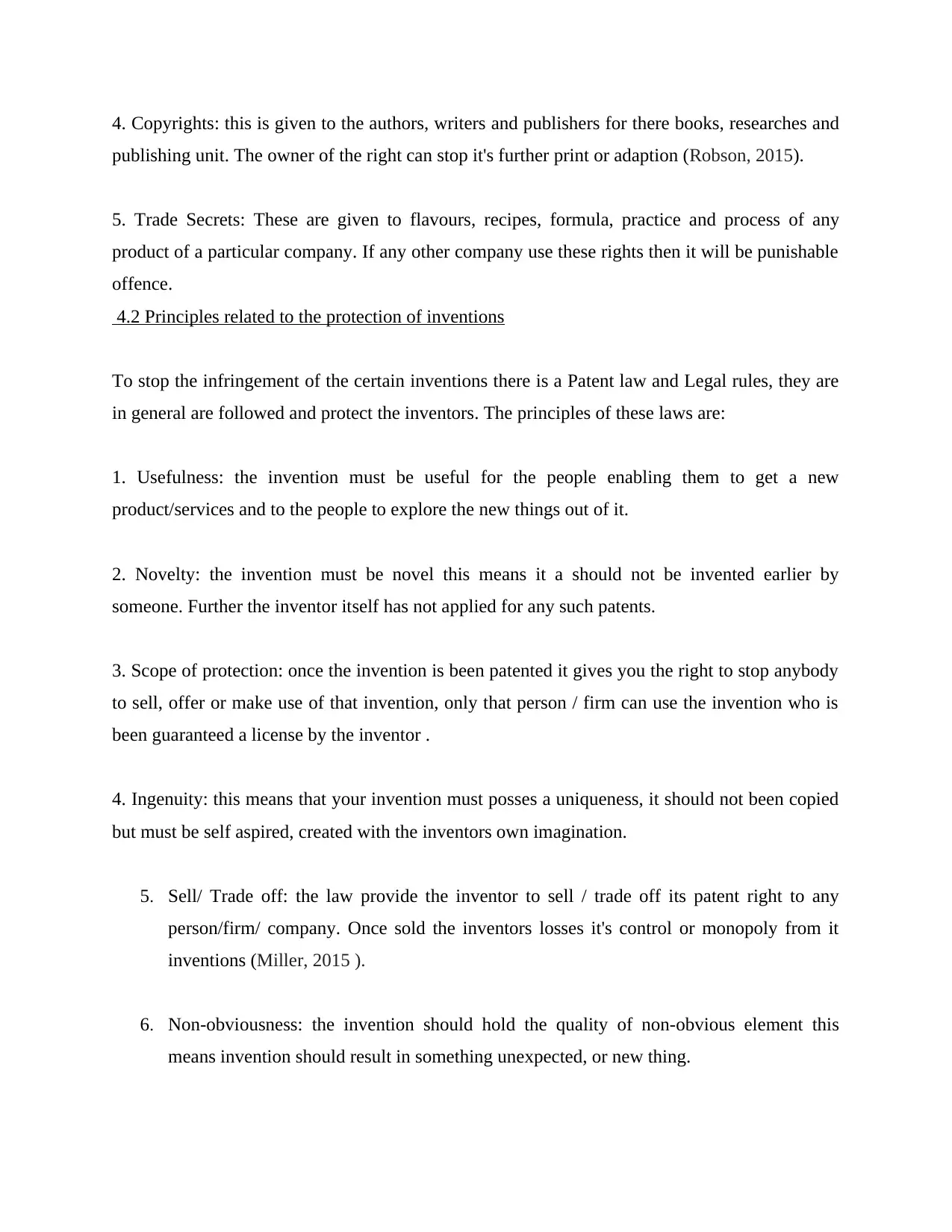
4. Copyrights: this is given to the authors, writers and publishers for there books, researches and
publishing unit. The owner of the right can stop it's further print or adaption (Robson, 2015).
5. Trade Secrets: These are given to flavours, recipes, formula, practice and process of any
product of a particular company. If any other company use these rights then it will be punishable
offence.
4.2 Principles related to the protection of inventions
To stop the infringement of the certain inventions there is a Patent law and Legal rules, they are
in general are followed and protect the inventors. The principles of these laws are:
1. Usefulness: the invention must be useful for the people enabling them to get a new
product/services and to the people to explore the new things out of it.
2. Novelty: the invention must be novel this means it a should not be invented earlier by
someone. Further the inventor itself has not applied for any such patents.
3. Scope of protection: once the invention is been patented it gives you the right to stop anybody
to sell, offer or make use of that invention, only that person / firm can use the invention who is
been guaranteed a license by the inventor .
4. Ingenuity: this means that your invention must posses a uniqueness, it should not been copied
but must be self aspired, created with the inventors own imagination.
5. Sell/ Trade off: the law provide the inventor to sell / trade off its patent right to any
person/firm/ company. Once sold the inventors losses it's control or monopoly from it
inventions (Miller, 2015 ).
6. Non-obviousness: the invention should hold the quality of non-obvious element this
means invention should result in something unexpected, or new thing.
publishing unit. The owner of the right can stop it's further print or adaption (Robson, 2015).
5. Trade Secrets: These are given to flavours, recipes, formula, practice and process of any
product of a particular company. If any other company use these rights then it will be punishable
offence.
4.2 Principles related to the protection of inventions
To stop the infringement of the certain inventions there is a Patent law and Legal rules, they are
in general are followed and protect the inventors. The principles of these laws are:
1. Usefulness: the invention must be useful for the people enabling them to get a new
product/services and to the people to explore the new things out of it.
2. Novelty: the invention must be novel this means it a should not be invented earlier by
someone. Further the inventor itself has not applied for any such patents.
3. Scope of protection: once the invention is been patented it gives you the right to stop anybody
to sell, offer or make use of that invention, only that person / firm can use the invention who is
been guaranteed a license by the inventor .
4. Ingenuity: this means that your invention must posses a uniqueness, it should not been copied
but must be self aspired, created with the inventors own imagination.
5. Sell/ Trade off: the law provide the inventor to sell / trade off its patent right to any
person/firm/ company. Once sold the inventors losses it's control or monopoly from it
inventions (Miller, 2015 ).
6. Non-obviousness: the invention should hold the quality of non-obvious element this
means invention should result in something unexpected, or new thing.
Paraphrase This Document
Need a fresh take? Get an instant paraphrase of this document with our AI Paraphraser
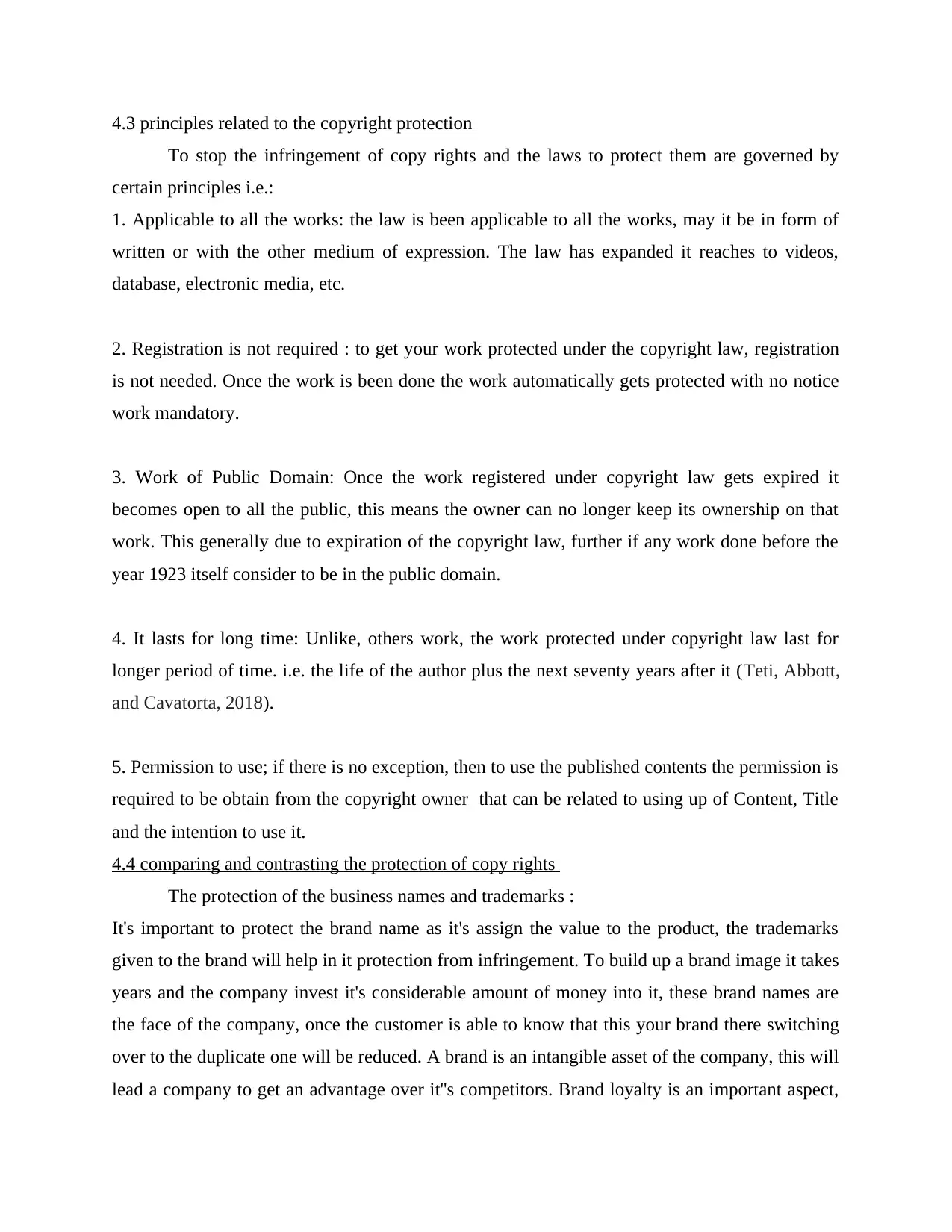
4.3 principles related to the copyright protection
To stop the infringement of copy rights and the laws to protect them are governed by
certain principles i.e.:
1. Applicable to all the works: the law is been applicable to all the works, may it be in form of
written or with the other medium of expression. The law has expanded it reaches to videos,
database, electronic media, etc.
2. Registration is not required : to get your work protected under the copyright law, registration
is not needed. Once the work is been done the work automatically gets protected with no notice
work mandatory.
3. Work of Public Domain: Once the work registered under copyright law gets expired it
becomes open to all the public, this means the owner can no longer keep its ownership on that
work. This generally due to expiration of the copyright law, further if any work done before the
year 1923 itself consider to be in the public domain.
4. It lasts for long time: Unlike, others work, the work protected under copyright law last for
longer period of time. i.e. the life of the author plus the next seventy years after it (Teti, Abbott,
and Cavatorta, 2018).
5. Permission to use; if there is no exception, then to use the published contents the permission is
required to be obtain from the copyright owner that can be related to using up of Content, Title
and the intention to use it.
4.4 comparing and contrasting the protection of copy rights
The protection of the business names and trademarks :
It's important to protect the brand name as it's assign the value to the product, the trademarks
given to the brand will help in it protection from infringement. To build up a brand image it takes
years and the company invest it's considerable amount of money into it, these brand names are
the face of the company, once the customer is able to know that this your brand there switching
over to the duplicate one will be reduced. A brand is an intangible asset of the company, this will
lead a company to get an advantage over it''s competitors. Brand loyalty is an important aspect,
To stop the infringement of copy rights and the laws to protect them are governed by
certain principles i.e.:
1. Applicable to all the works: the law is been applicable to all the works, may it be in form of
written or with the other medium of expression. The law has expanded it reaches to videos,
database, electronic media, etc.
2. Registration is not required : to get your work protected under the copyright law, registration
is not needed. Once the work is been done the work automatically gets protected with no notice
work mandatory.
3. Work of Public Domain: Once the work registered under copyright law gets expired it
becomes open to all the public, this means the owner can no longer keep its ownership on that
work. This generally due to expiration of the copyright law, further if any work done before the
year 1923 itself consider to be in the public domain.
4. It lasts for long time: Unlike, others work, the work protected under copyright law last for
longer period of time. i.e. the life of the author plus the next seventy years after it (Teti, Abbott,
and Cavatorta, 2018).
5. Permission to use; if there is no exception, then to use the published contents the permission is
required to be obtain from the copyright owner that can be related to using up of Content, Title
and the intention to use it.
4.4 comparing and contrasting the protection of copy rights
The protection of the business names and trademarks :
It's important to protect the brand name as it's assign the value to the product, the trademarks
given to the brand will help in it protection from infringement. To build up a brand image it takes
years and the company invest it's considerable amount of money into it, these brand names are
the face of the company, once the customer is able to know that this your brand there switching
over to the duplicate one will be reduced. A brand is an intangible asset of the company, this will
lead a company to get an advantage over it''s competitors. Brand loyalty is an important aspect,
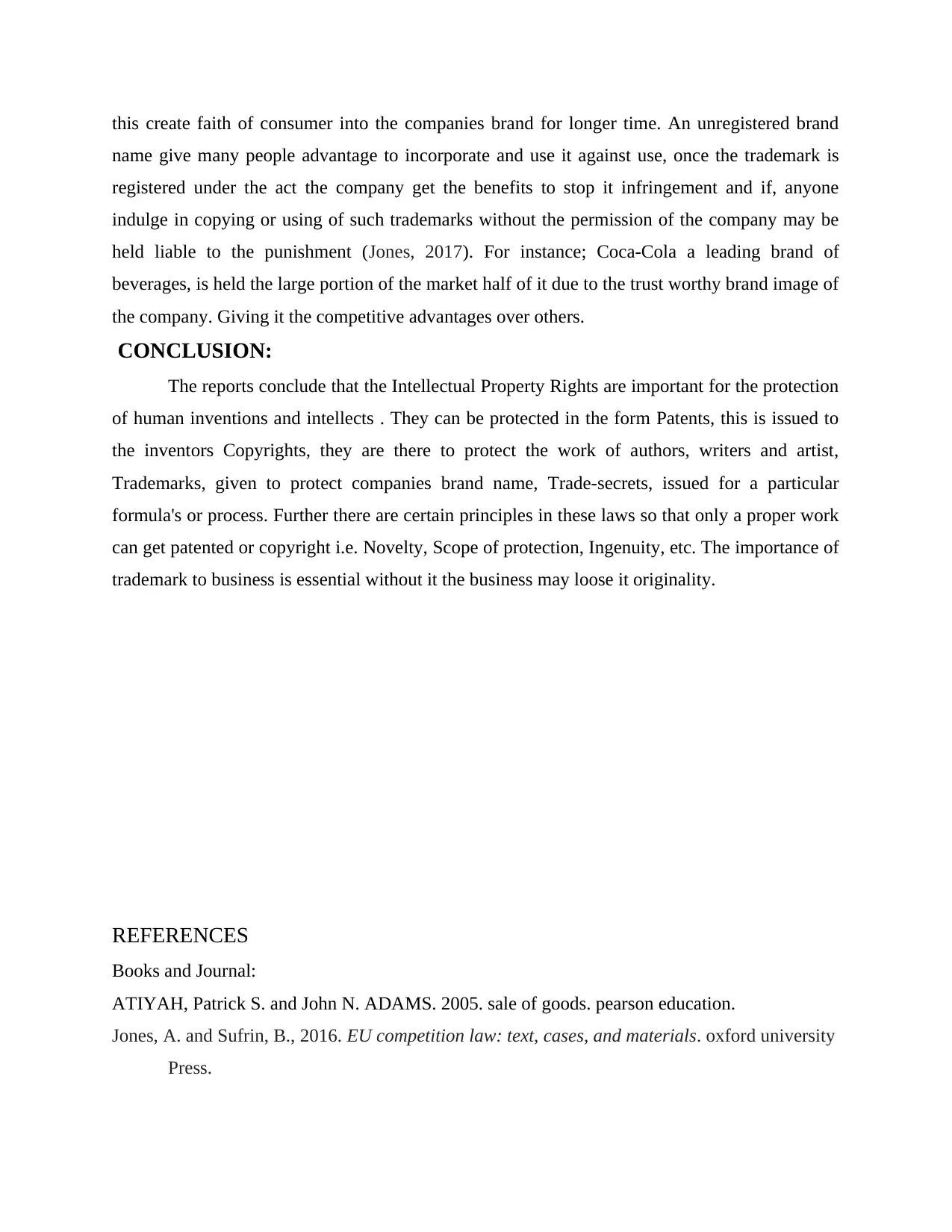
this create faith of consumer into the companies brand for longer time. An unregistered brand
name give many people advantage to incorporate and use it against use, once the trademark is
registered under the act the company get the benefits to stop it infringement and if, anyone
indulge in copying or using of such trademarks without the permission of the company may be
held liable to the punishment (Jones, 2017). For instance; Coca-Cola a leading brand of
beverages, is held the large portion of the market half of it due to the trust worthy brand image of
the company. Giving it the competitive advantages over others.
CONCLUSION:
The reports conclude that the Intellectual Property Rights are important for the protection
of human inventions and intellects . They can be protected in the form Patents, this is issued to
the inventors Copyrights, they are there to protect the work of authors, writers and artist,
Trademarks, given to protect companies brand name, Trade-secrets, issued for a particular
formula's or process. Further there are certain principles in these laws so that only a proper work
can get patented or copyright i.e. Novelty, Scope of protection, Ingenuity, etc. The importance of
trademark to business is essential without it the business may loose it originality.
REFERENCES
Books and Journal:
ATIYAH, Patrick S. and John N. ADAMS. 2005. sale of goods. pearson education.
Jones, A. and Sufrin, B., 2016. EU competition law: text, cases, and materials. oxford university
Press.
name give many people advantage to incorporate and use it against use, once the trademark is
registered under the act the company get the benefits to stop it infringement and if, anyone
indulge in copying or using of such trademarks without the permission of the company may be
held liable to the punishment (Jones, 2017). For instance; Coca-Cola a leading brand of
beverages, is held the large portion of the market half of it due to the trust worthy brand image of
the company. Giving it the competitive advantages over others.
CONCLUSION:
The reports conclude that the Intellectual Property Rights are important for the protection
of human inventions and intellects . They can be protected in the form Patents, this is issued to
the inventors Copyrights, they are there to protect the work of authors, writers and artist,
Trademarks, given to protect companies brand name, Trade-secrets, issued for a particular
formula's or process. Further there are certain principles in these laws so that only a proper work
can get patented or copyright i.e. Novelty, Scope of protection, Ingenuity, etc. The importance of
trademark to business is essential without it the business may loose it originality.
REFERENCES
Books and Journal:
ATIYAH, Patrick S. and John N. ADAMS. 2005. sale of goods. pearson education.
Jones, A. and Sufrin, B., 2016. EU competition law: text, cases, and materials. oxford university
Press.
⊘ This is a preview!⊘
Do you want full access?
Subscribe today to unlock all pages.

Trusted by 1+ million students worldwide
1 out of 13
Related Documents
Your All-in-One AI-Powered Toolkit for Academic Success.
+13062052269
info@desklib.com
Available 24*7 on WhatsApp / Email
![[object Object]](/_next/static/media/star-bottom.7253800d.svg)
Unlock your academic potential
Copyright © 2020–2025 A2Z Services. All Rights Reserved. Developed and managed by ZUCOL.




